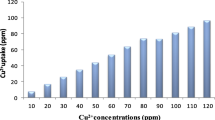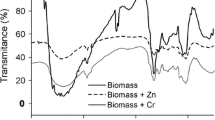Abstract
The chromium (CrIII and CrVI) removal capability of Rhizobium leguminosarum was checked by estimating the amount of chromium in the medium before and after inoculation. To determine the efficiency of R. leguminosarum in removal of chromium, the influence of physical and chemical parameters such as temperature, pH and different concentrations (0.1–1.0 mM) of trivalent (CrIII) and hexavalent (CrVI) chromium were studied. The chromium removal in aqueous solution by different size of active and inactivated biomass and immobilized cells of R. leguminosarum in a packed-bed column was also carried out. Results showed that in a medium containing up to 0.5 mM concentration of both CrIII and CrVI, R. leguminosarum showed optimal growth. The maximum chromium removal was at pH 7.0 and 35°C. Active biomass removed 84.4 ± 3.6% of CrIII and 77.3 ± 4.3% of CrVI in 24 h of incubation time. However, inactivated biomass removed maximum chromium after 36 h of incubation. Immobilized bacterial cells in a packed-bed column removed 86.4 ± 1.7% of CrIII and 83.8 ± 2.2% of CrVI in 16 and 20 h of incubation time, respectively.





Similar content being viewed by others
References
Agarwal SC, Rai SS, Muthur KC (1989) Some studies on chromium removal with coal. J Ind Water Works Assoc 2:133
ATSDR (1991) Toxicological profile for chromium. Agency for toxic substances and disease registry. US Public Health Service Atlanta, GA
Bajpai B, Banerjee T, Patil S (1999) Gallotannin hydrolysis by immobilized fungal mycelia in a packed bed bioreactor. Indian J Exp Biol 37:94–97
Chang YH, Kim JK, Kim HJ, Kim WY, Kim YB, Park YH (2001) Selection of a potential probiotic Lactobacillus strain and subsequent in vivo studies. Antonie van Leeuwenhoek 80:193–199
Chaudhry TM, Hill L, Khan AG, Kuek C (1999) Colonization of iron and zinc contaminated dumped filter cake waste by microbes, plants and associated mycorrhizae. In: Wang MH, Wang JWC, Baker AJM (eds) Remediation and management of degraded lands. CRS press LLC, Boca Raton, pp 275–283
De Flora S, Bagnasco M, Serra D, Zanacchi P (1990) Genotoxicity of chromium compounds. A review. Mutat Res 238:99–172
Dye M (1971) Functions and maintenance of Rhizobium collection. In: Subba Rao NS (ed) Recent advances in biological nitrogen fixation. Oxford and IBH, New Delhi, pp 435–471
Franco BV, Ann M, Gregory Olson J (1990) Chromium (VI) resistant yeast from a sewage treatment plant receiving tannery wastes. Appl Environ Microbiol 56:913–918
Fujie K, Tsuchida T, Urano K, Ohatake H (1994) Development of a bioreactor system for the treatment of chromate waste water using Enterobacter cloacae HO1. Water Sci Technol 33:235–243
Gadd GM (1990) Heavy metal accumulation by bacteria and other microorganisms. Experentic 46:834–840
Gadd GM, Mowll JL (1985) Copper uptake by yeast-like cells, hyphae and chlamydospores of Aureobasidium pullulans. Exp Mycol 9:230–240
Godjevargova Tz, Alexieva Z, Ivanova D (2000) Cell immobilization of Trichosporon cutaneum strain with phenol degradation ability on new modified polymer carriers. Process Biochem 35:699–704
Gruber JE, Jennette KW (1978) Metabolism of the carcinogen chromate by rat liver microorganisms. Biochem Biophys Res Commun 82:700–706
Gupta DC, Prasad G, Singh VN (1988) Removal of chrome dye from water by flyash. IAWPC Tech Annual 15:98
Hamilton HW, Wetterhahn KE (1988) Chromium. In: Seiler HG, Sigel H (eds) Handbook on toxicity of inorganic compounds. Marcel Dekker Inc, New York, pp 239–250
Huang C, Huei-Chin H (1994) Removal of trace Cd (II) from aqueous solutions by fungal adsorbents: An evaluation of self—immobilization of Rhizopus oryzae. Wat Sci Tech 30:245–253
Humphries AC, Macaskie LE (2002) Reduction of Cr(VI) Desulfovibrio vulgaris and Microbacterium sp. Biotechnol Lett 24:1261–1267
IARC (1990) Chromium, nickel and welding, monograph on the evaluation of the carcinogenic risk to humans, vol 49. International Agency for Research on Cancer, Lyon, p 677
Karna RR, Sajani LS, Mohan PM (1996) Bioaccumulation and biosorption of Co by Neurospora crassa. Biotechnol Lett 18:1205–1208
Khan AG (2001) Relation between chromium biomagnification ratio, accumulation factor, and mycorrhizae in plant growth on tannery effluent polluted soil. Environ Int 26:417–423
Khan QM, Challon G, Roux JC (1995) Removal of chromium from tannery wastewater using different biosorbents. Forum for Appl Biotechnol 9:27–29
Kumar PBAN, Dushenkov V, Motto H, Raskin I (1995) Phytoextraction, the use of plants to remove heavy metals from soil. Environ Sci Technol 29:1232–1238
Kunicka T, Rinkis G, Ramane HA (1992) Colorimetric method for chromium detection in biological materials. Latv Zinat Akad Vestis B Dala Dabaszinat 10:59–62
Lazaridis NK, Charalambous CH (2005) Sorptive removal of trivalent and hexavalent chromium from binary aqueous solutions by composite alginate—goethite beads. Water Res 39:4385–4396
Mahendran B (2002) Investigations of role of tannase and microbial consortium in tannery effluent treatment. Ph.D. thesis, University of Madras
Mahendran B, Raman N, Kim DJ (2006) Purification and characterization of tannase from Paecilomyces variotii: Hydrolysis of tannic acid using immobilized tannase. Applied Microbiol Biotechnol 70:444–450
Manuela Araujo M, Teixeira JA (1997) Trivalent chromium sorption on alginate beads. Int Biodet and Biodeg 40:63–74
Millick N, Rai LC (1994) Removal of inorganic ions from wastewaters by immobilized microalgae. World J Microbiol Biotechnol 10:439–443
Molina M, Abell T (1987) An ion chromatographic method for insoluble chromites in pain aerosol. Am Ind Hyg Assoc J 48:830–835
Ogawa T, Usui M, Yatome C, Idaka E (1989) Influence of chromium compounds on microbial growth and nucleic acid synthesis. Bull Environ Contam Toxicol 43:254–260
Pandey KK, Prasad H, Singh VN (1984) Removal of Cr (VI) from aqueous solutions by adsorption on flyash. Chem Tech Bio- Tech 34:367
Park CH, Keyhan M, Wielinga B, Fendorf S, Matin A (2000) Purification of homogeneity and characterization of a novel Pseudomonas putida chromate reductase. Appl Environ Microbiol 66:1795–1799
Peric IM, Campos VL, Mondaca MA, Moraga R, Zaror CA (2006) Evidential chromate bioreduction by capillary zone electrophoresis. J Chil Chem Soc 51:1030–1033
Petrilli FL, De Flora S (1977) Toxicity and mutagenicity of hexavalent chromium on Salmonella typhimurium. Appl Environ Microbiol 33:805–809
Ram B, Bajpai PK, Parwana HK (1999) Kinetics of chrome tannery effluent treatment by the activated sludge system. Process Biochem 35:255–265
Raman N, Sambandan K (1998) Distribution of VAM fungi in tannery effluent polluted soils of Tamil Nadu, India. Bull Environ Contamin Toxicol 60:142–150
Raman N, Srinivasan V, Ravi M (2002) Effect of chromium on the axenic growth and phosphatase activity of ectomycorrhizal fungi, Laccaria laccata and Suillus bovinus. Bull Environ Contam Toxicol 68:569–575
Rawat NS, Singh D (1992) Removal of chromium (VI) on bituminous coal. Asian Environ 14:30–41
Remoundaki E, Hatzikioseyian A, Tsezos M (2007) A systematic study of chromium solubility in the presence of organic matter: consequences for the treatment of chromium containing wastewater. J Chem Technol Biotechnol 82:802–808
Sabie FT, Gadd GM (1990) The effect of Zinc on the yeast-mycelium transition of Candida albicans and examination of zinc uptake at different stages of growth. Mycol Res 94:952–958
Selvaraj T (1998) Studies on mycorrhizal and rhizobial symbiosis on tolerance of tannery effluent treated Prosopis juliflora. Ph.D., thesis, University of Madras
Shakoori AR, Makhdoom M, Haq RU (2000) Hexavalent chromium reduction by a dichromate resistant gram—positive bacterium isolated from effluents of tanneries. Appl Microbiol Biotechnol 53:348–351
Siddiqui AA, Khursheed A, Farooqi IH, Siddiqui RH (1998) Economics of chromium recovery from spent chrome tan liquor. Indian J Environ Health 40:142–152
Singaram P (1994) Removal of chromium from tannery effluent by using water weeds. Indian J Environ Health 36:197–199
Snehalmove V, Sheeja J, Seetarama B, UnniNair B, Seetalaxman R (2001) Chromium removal and reduction in COD of tannery effluents by Actinomycetes. Indian J Environ Health 43:108–113
Suseela K, Sivaparvathi M, Nandy SC (1987) Removal of chromium from tannery effluent using powdered leaves. Leather Sci 34:149–156
Suzuki T, Miyata N, Horitsu H, Kawai K, Takamizawa K, Tai Y, Okazaki M (1992) NAD(P) H-Dependent chromium (VI) reductase of Pseudomonas ambigua G-1: a Cr (V) intermediate is formed during the reduction of Cr (VI) to Cr (III). J Bacteriol 174:5340–5345
Tirgar A, Golbabaei F, Hamedi J, Nourijelyani K (2011) Removal of airborne hexavalent chromium using alginate as a biosorbent. Int J Environ Sci Tech 8:237–244
Tobin JM, Roux JC (1998) Mucor biosorbent for chromium removal from tanning effluent. Water Res 32:1407–1416
Turick CE, Apel WA, Carmiol NS (1996) Isolation of hexavalent chromium reducing anaerobes from hexavalent—chromium—contaminated and non contaminated environments. Appl Microbiol Biotechnol 44:683–688
USEPA (1984) Health assessment document for hexavalent chromium EPA 540/1–86—019. US Environmental Protection Agency, Cincinnati
Varma B, Shukla NP (1999) Electrolytic separation of chromium from chrome tannery wastewater. Indian J Environ Health 41:43–48
Volesky B (1987) Biosorbents for metal recovery. Trends Biotechnol 5:96–101
Volesky B (1994) Advances in biosorption of metals: selection of biomass types. FEMS Microbiol Rev 14:291–302
Vyrides L, Stuckey DC (2011) Chromium removal mechanisms and bacterial community in an integrated membrane bioreactor system. Environ Eng Sci. doi:10.1089/ees.2010.0431
Wang YT, Shen H (1995) Bacterial reduction of hexavalent chromium. J Ind Microbiol 14:159–163
Wang P, Mori T, Komori K, Sasatsu M, Toda K, Ohtake H (1989) Isolation and characterization of an Enterobacter cloacae strain that reduces hexavalent chromium under anaerobic conditions. Appl Environ Microbiol 55:1665–1669
WHO (1988) Chromium, environmental health criteria, vol 61. World Health Organization, Geneva
Acknowledgments
The authors are thankful to Prof. N. Anand, Director, CAS in Botany, University of Madras for the facilities. Thanks are due to the Tamil Nadu Pollution Control Board, Chennai, India for the partial financial assistance.
Author information
Authors and Affiliations
Corresponding author
Rights and permissions
About this article
Cite this article
Raaman, N., Mahendran, B., Jaganathan, C. et al. Removal of chromium using Rhizobium leguminosarum . World J Microbiol Biotechnol 28, 627–636 (2012). https://doi.org/10.1007/s11274-011-0856-6
Received:
Accepted:
Published:
Issue Date:
DOI: https://doi.org/10.1007/s11274-011-0856-6




